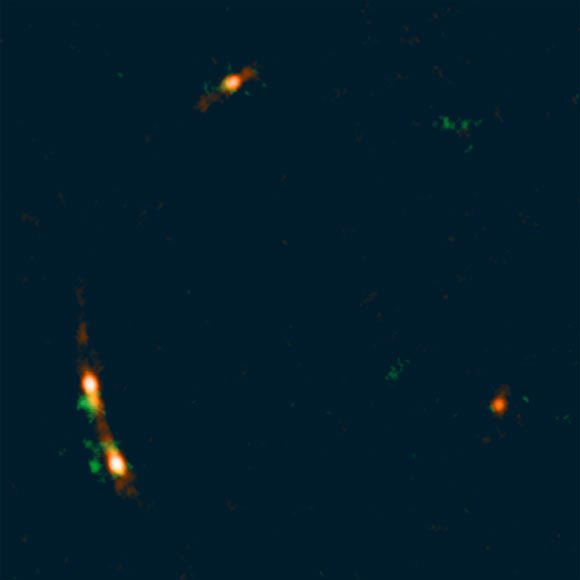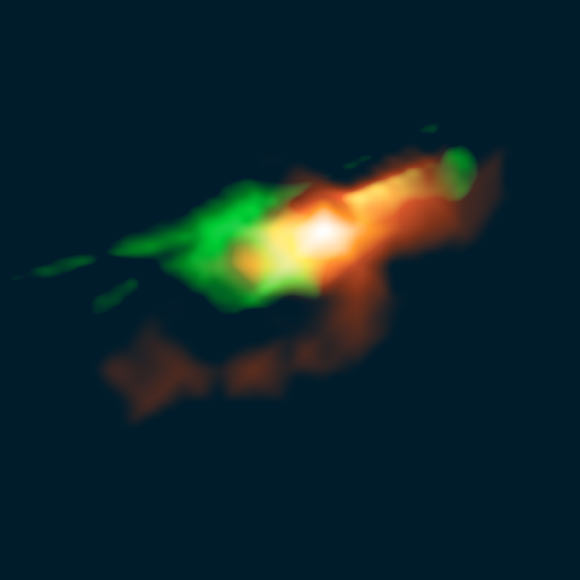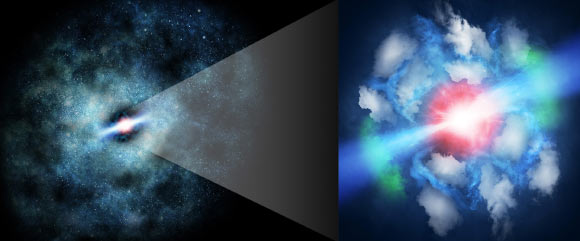ALMA Uses Cosmic Lens to Capture Disturbed Gas Clouds in Distant Quasar | Astronomy – Sci-News.com
By combining the power of strong gravitational lensing with the capability of the Atacama Large Millimeter/submillimeter Array (ALMA), a team of astronomers from Japan and Taiwan imaged disturbed gaseous clouds in a distant quasar called MG J0414+0534; the researchers also found that the disruption is caused by supermassive black hole jets.
“It is commonly known that black holes exert strong gravitational attraction on surrounding matter,” said senior author Dr. Takeo Minezaki, an astronomer in the Institute of Astronomy at the University of Tokyo, and colleagues.
“However, it is less well known that some black holes have fast-moving streams of ionized matter, called jets.”
“In some nearby galaxies, evolved jets blow off galactic gaseous clouds, resulting in suppressed star formation. Therefore, to understand the evolution of galaxies, it is crucial to observe the interaction between black hole jets and gaseous clouds throughout cosmic history.”
“However, it had been difficult to obtain clear evidence of such interaction, especially in the early Universe.”

This ALMA image shows the quadruply lensed quasar MG J0414+0534; emissions from dust and ionized gas shown in red and emissions from carbon monoxide gas shown in green. Image credit: ALMA / ESO / NAOJ / NRAO / Inoue et al.
Dr. Minezaki and co-authors used ALMA to capture high-resolution images of MG J0414+0534, a quadruply lensed quasar located 11 billion light-years away from Earth.
“The distortion works as a ‘natural telescope’ to enable a detailed view of distant objects,” Dr. Minezaki said.
Another feature is that MG J0414+0534 hosts a supermassive black hole with bipolar jets.
The astronomers were able to reconstruct the ‘true’ image of gaseous clouds as well as the jets in MG J0414+0534 by carefully accounting for the gravitational effects exerted by the intervening lensing galaxy.
“Combining this cosmic telescope and ALMA’s high-resolution observations, we obtained exceptionally sharp vision, that is 9,000 times better than human eyesight,” said co-author Dr. Kouichiro Nakanishi, an astronomer at the National Astronomical Observatory of Japan and SOKENDAI.
“With this extremely high resolution, we were able to obtain the distribution and motion of gaseous clouds around jets ejected from a supermassive black hole.”

A reconstructed image of what MG J0414+0534 would look like if gravitational lensing effects were turned off. The emissions from dust and ionized gas around a quasar are shown in red. The emissions from carbon monoxide gas are shown in green, which have a bipolar structure along the jets. Image credit: ALMA / ESO / NAOJ / NRAO / Inoue et al.
The researchers found that gaseous clouds along the jets have violent motion with speeds as high as 600 km/s, showing clear evidence of impacted gas. Moreover, it turned out that the size of the impacted gaseous clouds and the jets are much smaller than the typical size of a galaxy at this age.
“We are perhaps witnessing the very early phase of jet evolution in the galaxy. It could be as early as several tens of thousands of years after the launch of the jets,” said co-author Dr. Satoki Matsushita, an astronomer at the Academia Sinica Institute of Astronomy and Astrophysics.
“MG J0414+0534 is an excellent example because of the youth of the jets,” added Kindai University’s Professor Kaiki Inoue, first author of the study.
“We found telltale evidence of significant interaction between jets and gaseous clouds even in the very early evolutionary phase of jets. I think that our discovery will pave the way for a better understanding of the evolutionary process of galaxies in the early Universe.”
The findings were published in the Astrophysical Journal Letters.
_____
Kaiki Taro Inoue et al. 2020. ALMA 50-parsec-resolution Imaging of Jet–ISM Interaction in the Lensed Quasar MG J0414+0534. ApJL 892, L18; doi: 10.3847/2041-8213/ab7b7e







